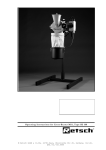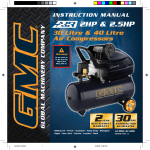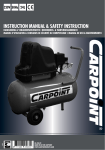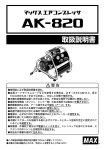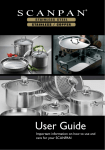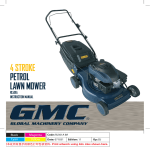Download RHINO 148cc B&S450 Instruction manual
Transcript
INSTRUCTION MANUAL by MOWMASTER ZZZPRZPDVWHUFRQ] 148cc B&S450 engine 400mm(16") cutting width 434mm(17") deck size PETROL LAWN MOWER Contents Caution 3 Environmental protection 3 Description of symbols 3 Specifications 4 Safety rules for petrol lawn mowers 4 Operation safety instructions 6 Unpacking 7 Contents of carton 7 Know your product 8 Assembly 9 Cutting height adjustment 10 Checking the oil 10 Fuelling 10 Starting, running and stopping the engine 11 Mowing advice 11 Engine starting check list 12 Maintenance 13 Catcher 13 Changing the mower blade 13 Oil change 14 Transporting 14 Storage 14 2 Fill the mower engine with adequate recommended oil before starting. Flammable material. Use at a distance of at least 15m from other people. equipment Extremely hot surface. Do not touch a hot muffler, gear box or cylinder. You may get burned. These parts get extremely hot from operation and remain hot a short time after the unit is turned off. Thrown objects and rotating blades can cause severe injury. CAUTION. Before carrying out any operation stop the engine and disconnect the spark plug cap. CAUTION. Risk of hand and feet injuries. Description of symbols Conforms to relevant standards for electromagnetic compatibility The rating plate on your equipment may show symbols. These represent important information about the product or instructions on its use. Wear hearing protection. Wear eye protection. Wear breathing protection. Wear safety gloves. Wear safety footwear. Read these instructions for use carefully. Warning. 3 Specifications Safety rules for petrol lawn mowers Engine: FOUR STROKE Engine Capacity: 148cc B&S450 Speed: 2850min-1 Fuel Type: Unleaded petrol Oil Type: 4 Stroke Motor Oil 10-30W Width of cut: 16” /400mm Blades: Single bar blade Height adjustment: 8 Levels, 10 – 70mm Wheel Size: 150mm/6” Weight (GW): 22.5kg Training • Read the instructions carefully. Get familiar with the controls and proper use of the equipment. • Only use the lawn mower for the purpose for which it was designed, i.e. for cutting and collecting grass. Any other use can be hazardous, causing damage to the machine. • Never allow children or people unfamiliar with these instructions to use the lawn mower. Local regulations may restrict the age of the operator. • Never use the lawn mower: – When people, especially children, or pets are nearby. – If the operator has taken medicine or substances that can affect his ability to react and concentrate. • Remember that the operator or user is responsible for accidents or hazards occurring to other people or their property. Preparation • While mowing, always wear sturdy footwear and long trousers. Do not operate the equipment when barefoot or wearing open sandals. • Thoroughly inspect the area where the equipment is to be used and remove all objects which may be thrown by the machine or damage the cutter assembly and the engine (stones, sticks, metal wire, bones, etc.) • WARNING: DANGER! Engine fuel is highly flammable: – Store fuel in containers specifically designed for this purpose. – Refuel using a funnel and outdoors only. Do not smoke while refuelling or whenever handling the fuel. – Add fuel before starting the engine. Never remove the cap of the fuel tank or add fuel while the engine is running or when the engine is hot. – If fuel is spilled, do not attempt to start the engine but move the machine away from the area of spillage and avoid creating any source of ignition until the fuel has evaporated and the vapour dispersed. 4 • Start the engine carefully, following the instructions and keeping feet well away from the blade. • Do not tilt the lawn mower when starting the engine. Start the engine on a flat surface that is free of obstacles and tall grass. • Do not put hands or feet near or under rotating parts. Keep clear of the discharge opening at all times. • Never pick up or carry a lawn mower while the engine is running. • Stop the engine and disconnect the spark plug wire: – Before carrying out any work underneath the cutting deck or before unclogging the chute; – Before checking, cleaning or working on lawn mower; – After striking a foreign object. Inspect the lawn mower for damage and make repairs before restarting and operating the lawn mower; – If the lawn mower starts to vibrate abnormally (find and remove the cause of the vibration immediately). • Stop the engine: – Whenever you leave the lawn mower unattended. Remove the key from models with electric starters. – Before refuelling. – Every time you remove or replace the grass-catcher. • Reduce the throttle before turning off the engine and turn the fuel off when you have finished mowing, following the instructions in the engine handbook. • When mowing, always keep to a safe distance from the rotating blade. This distance is the length of the handle. • Never cut grass while walking backwards. • Stop the engine before pushing mower across gravel drives, walks or roads. • This machine is to be used exclusively for cutting natural grass. Never use the mower for other purposes. Any other utilization can involve danger for your safety and can involve damage to the mower. – Replace all fuel tanks and containers caps securely. • Substitute faulty silencers. • Before use, always inspect the machine, especially the condition of the blades, and check that the screws and cutting assembly are not worn or damaged. Replace worn or damaged blades and screws in sets to preserve balance. • Discharge openings must be guarded at all times. Do not remove the discharge guard or hold it up while mowing. • It is advisable to wear suitable eye protection when operating the mower. Operation • Check and fill engine with recommended oil before starting. • Do not operate the engine in a confined space where dangerous carbon monoxide fumes can collect. • Mow only in daylight or good artificial light. • If possible, avoid operating the equipment in wet grass. • Always be sure of your footing on slopes. • Walk, never run and do not allow yourself to be pulled along by the lawn mower. • Mow across the face of slopes, never up and down. • Exercise extreme caution when changing direction on slopes. • Do not mow on slopes of more than 20°. • Exercise extreme caution when pulling the lawn-mower towards you. • Stop the blade if the lawn mower has to be tilted for transportation when crossing surfaces other than grass, and when transporting the lawn mower to and from the area to be mowed. • Never operate the lawn mower with defective guards, or without safety devices, such as the stoneguard and/or grass-catcher, in place. Replace if damaged. • Do not change the engine governor settings or over speed the engine. • On power-driven models, disengage the drive clutch before starting the engine. 5 • The user is responsible for the safety of other people, animals and objects in the working area. Keep children and domestic animals at a safe distance while the mower is in use. Maintenance and storage • Keep all nuts, bolts and screws tight to be sure the equipment is in safe working condition. Regular maintenance is essential for safety and performance. • Never store the equipment with fuel in the tank inside a building where vapour may reach a flame or a spark or a source of extreme heat. • Allow the engine to cool before storing in an enclosed space. • To reduce the fire hazard, keep the engine, exhaust silencer, battery compartment and fuel storage area free of grass, leaves, or excessive grease. Do not leave containers with grass cuttings in rooms. • Check the stone-guard and grass-catcher frequently for wear and deterioration and replace if damaged. • If the fuel tank has to be drained, this should be done outdoors and when the engine is cool. • Wear strong work gloves when removing and reassembling the blade. • Check the blade’s balance after sharpening. • For reasons of safety, do not use the equipment with worn or damaged parts. Parts are to be replaced and not repaired. Parts that are not of the same quality can damage the equipment and be dangerous for your safety. • Whenever the machine is to be handled, transported or tilted you must: – wear strong working gloves; – grasp the machine at the points that offer a safe grip, taking account of the weight and its distribution. • Damaged blades and worn bolts are major hazards. • Fuel goes off in about 3 - 4 months. If you find your mower does not start, try changing the fuel in the tank with newly purchased fuel. Operation safety instructions WARNING: Stop the engine and unplug the spark plug before any repairs or maintenance operations. • Check that all nuts, bolts and screws are well tightened before every use. • Before mowing ensure that the blade and the blade fixing screw are securely fastened. When the blade edges require re-sharpening, this must be done evenly on both sides to prevent any imbalance. If the blade is damaged, it must be replaced. • When mowing always wear long trousers and strong, covered footwear. • Do not run the engine in an enclosed and/or poorly ventilated area. The gas of the engine contains carbon monoxide, which is dangerous to your health. • Work only when there is sufficient light. • Do not use the lawn mower when it is raining or when the grass is wet. • Caution must be taken while mowing on slopes. Mow across the face of slopes, never down or up. • Turn off the engine if you must leave the lawn mower unattended. • Never lift the rear of the mower while starting the engine and never place your hands and feet underneath the deck while the engine is running. • If working on high grass, adjust the mowing height to reduce the friction and prevent over loading. The optimal mowing height should be 1/3 the height of the grass. It would affect the work efficiency of lawn mower if too higher or lower. • Never change the rated speed of the engine in any way . • Never lift or carry the mower while the engine is running. • Stop the engine and remove the spark plug cover in these cases: - Before any operation under the deck. - Before any maintenance, repairing or checking operations. 6 - Before carrying, lifting or removing the mower. - If you leave the mower unattended or change the cutting height. - After hitting a foreign object, stop the engine and check thoroughly the mower in order to see if it is damaged. Take the mower to an authorized service centre to carry out any repairs if necessary. - If the mower vibrates in an abnormal way, take the mower to an authorized service centre. - Check the bolts and nuts regularly. Bolts and nuts may vibrate loose over time. WARNING: Fuel is highly flammable. • Keep fuel in a jerry can specially made for this purpose. • Fill the fuel tank with a funnel and outside. Do not smoke or use a mobile phone during this process. • Fill with fuel and oil before starting the engine. Never open the cap of the fuel tank to add gasoline while the engine is running or still hot. • Do not start the engine if there is spilt fuel on the mower or in the area surrounding. Take the mower away from the zone where fuel has been split and avoid any contact from a hot source as long as the split gasoline is completely evaporated. • Tighten the fuel tank cap and jerry can cap tightly. Unpacking Due to modern mass production techniques, it is unlikely that your lawn mower is faulty or that a part is missing. If you find anything wrong, do not operate the equipment until the parts have been replaced or the fault has been rectified. Failure to do so could result in serious personal injury. Contents of carton • Handle bar locking knobs, (including 2 bolts) • 40L Soft catcher 7 Know your product 1. Handle bar 2. Lower handle 3. Throttle lever 4. Wheel 5. Catcher 6. Height adjustment lever 7. Fuel tank cap 8. Oil filler cap 9. Recoil starter 10. Spark plug cap 11. Handle bar locking knob 12. Discharge guard 13. Blade 14. Blade bolt 1 3 11 2 5 8 9 12 6 7 10 13 14 4 8 Attaching the handles It is necessary to attach both the lower handle and handle bars. 1. To attach the lower handle (2), first use a spanner (not supplied) to remove the 4 bolts. 2. Place the lower handle in position and replace the 4 bolts. Use a spanner to retighten the nuts. 3. To attach the handle bar (1), first remove the two handle bar locking knobs (12). 4. Position the handle bar over the lower handle and insert the two locking knobs. Tighten to secure the handles together and in place. Assembly WARNING: Stop the engine and unplug the spark plug before any repairs or maintenance operations. It is necessary to fit the lower handle (2), handle bar (1), and catcher (5) to the mower. Attaching the catcher 1. Lift the discharge guard (15) in order to position the catcher. 2. While lifting the discharge guard, align the holes in the lower half of the catcher with the hooks on the mower deck (located under the discharge chute). Push the catcher onto the hooks in a downwards direction. 3. Push the catcher down until it locks into place. 4. Release the discharge guard to secure the catcher in place between the 2 ribbed locking notches. Note. Always empty the catcher before it has reached maximum capacity, otherwise it will decrease the performance of the mower. Tip. Do not leave clippings in the catcher for extended periods. 9 5. Retighten the oil filler cap firmly before starting the engine. Cutting height adjustment WARNING: Stop the engine and unplug the spark plug before any repairs or maintenance operations. The mower has one lever to easily adjust the cutting height. There are 7 height settings. 1. To decrease the cutting height pull the height adjustment lever (6) out and move it up a notch, towards the handlebar. 2. To increase the cutting height pull the lever out and move it down a notch, towards the engine. Note. If you are unsure of which cutting height to use, begin with a high setting and trial a small section of lawn, then check the appearance of the lawn. Then readjust if necessary IMPORTANT. If mower is not used for an extended period of time (3 months or more) fuel and oil must be decanted (emptied) then replaced before the next use. Fuelling IMPORTANT. Fuel goes off after about 3-4 months. If you find your mower does not start, first change the fuel in the tank with newly purchased fuel. Note. Use fresh unleaded petrol. 1. Unscrew the fuel tank cap (7) and pour unleaded petrol into the tank with the aid of a funnel. 2. Fill the tank to approximately 2.5 cm below the lowest portion of the neck to allow for fuel expansion. Be careful not to over fill. 3. Be careful not to spill any petrol, if this happens, wipe the spill with a clean rag. 4. Start the engine at least three meters away from the area where the fuel tank has been filled in order to avoid the risk of fire. WARNING. Never attempt to refuel the engine while it is running or still warm, allow it to cool before fuelling. Checking the oil 1. Move the lawn mower to a level surface and clean around the oil filler cap (8) . 2. Remove the oil filler cap with dipstick and wipe it with a clean cloth. Replace it and retighten the cap. 3. Remove the dipstick again and check the oil level, the oil should be at the full (‘max’) mark. Max 4. If oil is required add it slowly (the oil capacity is about 0.6 litre), do not over fill. 10 Starting the engine Note. Before starting the mower check the oil and fuel levels. 1. Move the throttle lever (3) to the start position. 2. Push the primer bulb firmly 5 times (for initial starting) or 3 times (for engine starting thereafter). Mowing advice 1. It is recommended to use the fast throttle setting and keep the engine running at maximum speed. This will deliver the best cut and extend engine life. If the speed of the engine slows this could indicate the mower is being overloaded, by trying to cut too much grass or the catcher may be full. Try mowing a narrower strip, mowing slower, raising the cutting height or emptying the catcher. 2. Before mowing always check and clear the grassed area for all foreign objects, especially solid ones semi concealed in the ground such as rocks, stumps and garden stakes. 3. Sharp blades cut cleanly and efficiently, if the blade is dull it will tear the grass. This will result in the ends turning brown. When the blades no longer cut cleanly either sharpen them or replace them. 4. To safely operate the mower ensure all four wheels are on the ground and be careful not to loose your footing or control of the mower. Be very careful when mowing uneven or rough ground. Keep a firm grip on the handle bar at all times, always walk, never run with the mower. 5. For healthy growth, grass should not be cut too short. The grass will remain healthier, greener and require less watering. 6. Vary your cutting pattern from week to week, this will help to prevent matting and graining of the grass. 7. Before checking a clogged mower deck stop the engine completely and disconnect the spark plug lead and then tilt the mower so the air filter side is facing upwards. Use a stick the clear any clogged material, never use your hands. 3. Pull the recoil starter (9) lightly until you feel resistance then pull quickly until the engine starts. Do not pull the cord with a jerk or release it until fully rewound. 4. Once the lawn mower has started and warmed up move the throttle lever to the Run position. Stopping the engine To stop the engine reduce the speed of the engine by pulling the throttle lever (3) towards the tortoise. 11 8. Mowing wet grass should be avoided. Wet grass will clog the mower deck and if it is slippery you may lose your footing. 9. Always mow across slopes not up and down them. Be extra careful if the grass is wet as this could cause you to slip and lose control of the mower. 10. If the ground is too dry, mowing will stir up a lot of dust which may clog the air filter. In these conditions it is recommended to water your lawn the day before mowing. 11. Use the side of the mower as a guide to cut close to large objects such as a fence or a wall. Be careful when mowing over obstacles embedded in the lawn such as sprinkler systems and paving, avoid anything that sticks up above the surface of the lawn. 12. Avoid mowing over loose stones, gravel and other landscaping material as this can be picked up by the mower and flung out causing serious personal injury. 13. If the blades do come into contact with something or the mower starts to vibrate stop the engine immediately, remove the spark plug lead and inspect the blades to see if there is any damage. Remove the spark plug and check that the end is not blackened by carbon build up. Clean with a soft wire brush if necessary. Test the spark plug ignition by disconnecting the spark plug wire from the spark plug. Hold the end of the spark plug wire close to a metal surface. If the spark plug is good, you will see a spark or you’ll hear a crackling noise. This means that voltage is getting through the wire to the spark plug. Note: This should only be carried out by a confident end user as if not careful, this procedure may result in a non lethal electric shock. Petrol fumes and people with pace makers need to be taken into consideration when checking the spark this way. Air filter Check that the air filter is clean and dry. Filters thick with debris will not allow the engine to breath and result in difficult starting and poor engine performance Engine tipping When cleaning, or performing any maintenance such as replacing the blades, it is very important that the mower is only tipped backwards. Failing to do so will result in the engine oil flowing into the cylinder and muffler making starting very difficult if at all. Should this occur, the mower should be taken to a mower repair shop which is not covered under warranty. Poor engine performance Should the engine idle or run rough at full speed with excessive bluey/black smoke emanating from the muffler, it is possible that either the engine was slightly tipped incorrectly (refer above) or the carburettor is set to rich. With the engine running, adjust the mixture screw back slightly until performance improves. This screw is located through a slot in the front of the air filter cover. Engine starting check list Check the oil level The correct level is achieved by first ensuring mower is on a level surface. Then with the dip stick screwed in oil the way in and then back out again, check the level is to the “Max” indicator line. Make sure it is not over-filled. Max Fuel check As fuel can go off relatively quickly, make sure you are using fresh unleaded fuel and don’t overfill the tank. Spark plug Check the spark plug cable is firmly fitted to the top of the spark plug. 12 Maintenance 1. Periodically check the blade (14) for nicks and dull cutting edges and have it sharpened if needed. WARNING. When cleaning, or performing any maintenance such as replacing the blades, it is very important that the mower is only tipped backwards. Failing to do so will result in the engine oil flowing into the cylinder and muffler making starting very difficult if at all. Should this occur, the mower should be taken to a mower repair shop which is not covered under warranty Note. The blade should be sharpened and balanced by an authorised repair centre. 2. If there are rounded or broken ends, thinned metal or other damage, replace the blade. 3. With the engine switched off, lift the front of the mower upwards so the handle bar sits on the ground and the spark plug faces upwards. Note. Improper tipping may affect engine performance. 4. Put on a pair of sturdy gloves to protect your hands. 5. Block the rotation of the blade (14) and use a spanner (not supplied) to unscrew the blade bolt (15) in an anti-clockwise direction (viewed from underneath). 6. Replace the blade (14) and screw in the blade bolt (15), tightening it with a spanner (not supplied). Note. When reassembling the blade, ensure the cutting edges face in the direction of the engine rotation. 7. Return the mower to the upright position. 8. Start the engine and allow the mower to run for a few minutes to check that the blade is properly fitted and that there is no undue noise or vibration. Use only the blade as recommended by the manufacturer Catcher CAUTION. Before making any adjustment or maintenance procedures to the mower ensure it is turned off and the spark plug lead is removed. To remove the catcher, raise the guard while lifting the catcher to dislodge it from the hooks. WARNING. Check the catcher frequently for cracks and wear and replace it if damaged. Changing the mower blade CAUTION. 1.Stop the engine and unplug the spark plug before any repairs or maintenance operations. 2.Do not over tilt the mower when changing or checking the blade. 3.Never carry out any assembly operations or adjustments with the engine running. The blade is made of pressed steel. In order to obtain a clean cut, sharpen the blade periodically after every 25 hours of use. Ensure that the blade is always well balance. A badly balanced blade can involve harmful vibrations and may cause injury. 13 Oil change Storage IMPORTANT. Drain the oil while the engine in still warm to ensure rapid and complete draining. 1. Remove the oil cap dipstick (8) and drain plug underneath the engine to drain the oil. 2. Turn up right and clean up any spillage and refill with fresh oil checking the level as you go. 3. Reinstall the oil fill cap dipstick. Note. Please dispose of used motor oil in a manner that is compatible with the environment. We suggest you take it in a sealed container to your local service station for reclamation. Do not throw it in the trash or pour it into the earth. • When you finish working, clean the engine completely, making sure there is no grass or dirt on the engine. • Store the engine away from direct sunlight. • At the end of the season, give the engine an overall cleaning and a thorough check. • Whenever the machine is not used for a long period of time, proceed as follows: • Empty the fuel tank completely. • Protect all metal engine parts from corrosion by coating them with oil. • Remove the spark plug, put a few drops of oil into the cylinder and then pull the recoil starter 2 to 3 times in order to distribute the oil evenly. Replace the spark plug. This closes the valves, and protects them from dust and corrosion. Coat areas that may rust with a light film of oil. Cover the engine and store it on a level surface in a dry, dust free area. Transporting CAUTION. If the engine must be tipped to transport equipment or to inspect or remove grass, keep the spark plug upwards. Transporting or tipping the engine spark plug down may cause: • Smoking • Hard starting • Spark plug fouling • Oil saturation of the air filter Ensure the storage area is free from excessive humidity and dust. Drain the fuel tank and carburettor. WARNING. Fuel is extremely flammable and explosive under certain conditions. Do not smoke or allow flames or sparks in the area. Note. Be aware to not hit or cut the fuel tank while you are transporting. 14














